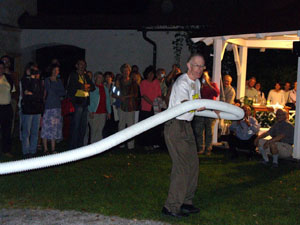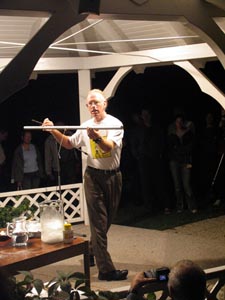
Paul Doherty playing the giant whirly outside of Bistra Castle. Photo by Christian Ucke
GIREP 2005 Ljubljana Slovenia
This is a draft version, the complete web page will be posted Monday 12 September 2005.
Lecture at the GIREP seminar
For my evening lecture go to the bottom of this page.
Learning Science by Doing Science with Simple Materials
Here are some of the major themes in my presentation, followed by descriptions of the experiments.
Museums Need Scientist/teachers
Scientists are usually specialists in a narrow area of science. In this area they can answer the question, "How do you know that?" by referring to fundamental experiments.
Teachers must know the broad landscape of science. They must understand how scientific topics relate to each other. They must also know how to motivate learners, how to make science relevant, and how to explain science clearly.
Combine the two, and you have a museum scientist/teacher.
The scientist is a composer, creating new ways of understanding.
The teacher is the arranger, putting things together for the audience,
Learners play the arrangements.
The scientist/teacher plays Jazz.
The scientist/teacher must consider the observer.
Example: If you make a real image of a distant object with a lens and then look through the lens from a large distance you will see the inverted real image. However if you approach the lens closely you will see a right-side up virtual image. By ray tracing scientists will say the image is real, how can it be virtual. It is virtual when you consider the eye of the observer, a variable focus lens that can make a right-side-up image on the retina.
Science Writing
Scientists write with great precision so they cannot be misunderstood by other scientists but perhaps so they cannot be understood by the public.
When writing for the public, write so there is at least one way that the writing can be interpreted correctly.
All of my science answers have an asterisk attached
* It's more complicated than that.
This allows me to actually answer science questions, when it is appropriate I use Newton's laws, I only use general relativity when I am forced to.
Without the asterisk I would have to tell my calculus physics class as they finish their final exam:
You have just learned Newton's Laws
They are wrong.
Science is composed of lies
very precise lies.
We know exactly how wrong they are.
The Exploratorium,
A museum of science, art, and human perception.
A hands-on museum in San Francisco founded by Frank Oppenheimer, a physicist and featuring many physics exhibits where people experience and explore the phenomena of science.
Center for Public Exhibition
There are 500 exhibits on the floor at on time, We create about 1 new exhibit a week.
We build exhibits by creating working prototypes. The prototypes evolve into exhibits as they are used by staff and visitors.
Physicists are needed to help make the exhibits work and to get the science behind the exhibits correct. (5 Ph.D. physicists)
Center for Learning and Teaching
The museum has a website www.exploratorium.edu, with 15,000 pages. Free with no registration required. We are website number 600 and one of the few museums which is an edu.
The entire Science Snackbook is online.
It tells how to build versions of our $10,000 exhibits for $10, and describes the physics behind the exhibits.
http://www.exploratorium.edu/snacks
Visitors take a virtual trip to Epsilon Eridani, a star 10 light years from earth. The website shows the relativistic effects that happen during the trip. It then shows the proof that the relativistic effect actually occurs during experiments. It helps visitors do the mathematics of relativity, and it explores some relativistic brainteasers.
Teacher Programs:
The Teacher Institute: 2000 alumni teachers: high school physics, mathematics and biology plus middle school physical science, mathematics, and life science.
We bring them in for a 100 hour summer Institute over a month. 4 days a week we work as follows: 1.5 hours at exhibits, 1.5 hours using Snacks, 2 hours teachers building class sets of exhibits in our teacher machine shop and researching the science behind the exhibits in our library. Then on the fifth day the teachers present to us and to each other.
Here is the syllabus for a 4 week long summer institute.
They then return for 2 week alumni sessions, for Saturday workshops, and they become members of our online list serve named "Pinhole."
Iron Science Teacher
Like Iron Chef. Six teachers are given an ingredient and create a 5 minute science lesson using that ingredient.
Breaking Science News
Mars Rovers, Cassini-Huygens Saturn, CERN and antimatter.
Real or Virtual images in a lens, Look through a lens at a distant object, invert the image by changing your position.
Find the Rays, look at a bright small source of light in a dimly lit room, notice the rays of light spreading out from the light. Do simple experiments to find out where those rays are really located.
Soap Film in a can., Make a soap film over the mouth of a black film can, observe interference colors in the film.
Soap Film Interference, Model soap film interference color production with waves drawn on paper.
Soap Film Colors, Add up the reflected colors to get the color of a soap film.
Permanent Oil Slick, Make a long-lasting set of interference colors with clear nail polish.
Magnetic levitation, floating in copper.
Repel a Grape, Use diamagnetism to push a grape on a torsional pendulum.
Metal detector Barkhausen effect, use a coil of wire around an iron slug connected to am amplified speaker to make a metal detector and to hear the Barkhausen effect, the actual motion of magnetic domain walls.
Digital audio tape, Uses pieces of audio tape to make a digital tape recorder one byte long.
Elastic and Inelastic magnetic collisions on a pencil collide donut magnets.
Mars Baseball, An Atwoods machine can be built to create the acceleration of gravity on Mars.
Gravity Well, different shapes of potential wells create different varieties of Kepler's laws.
Tides, and Gravity Well Model of Tides.
Gravity Assist How a small ball bouncing on a larger ball is like a spacecraft getting a gravity assist.
CD spectrometer, use a compact disk to make a spectrometer.
CD spectra, use a compact disk to reflect sunlight onto a shadowy wall.
Flying Hydra, use a charged electric rod to fly a frayed piece of nylon.
Flying tinsel Use a charged electric rod to fly pieces of aluminized mylar.

Whirly, Making music with corrugated plastic tubes.
Ringing Rod Playing sounds and looking for nodes on an aluminum rod.

Burning magnesium in Carbon Dioxide, do just what it says.
Bell on a Horn., how bells direct sound and allow sound to exit from an open tube.

|
Scientific Explorations with Paul Doherty |
|
27 July 2005 |